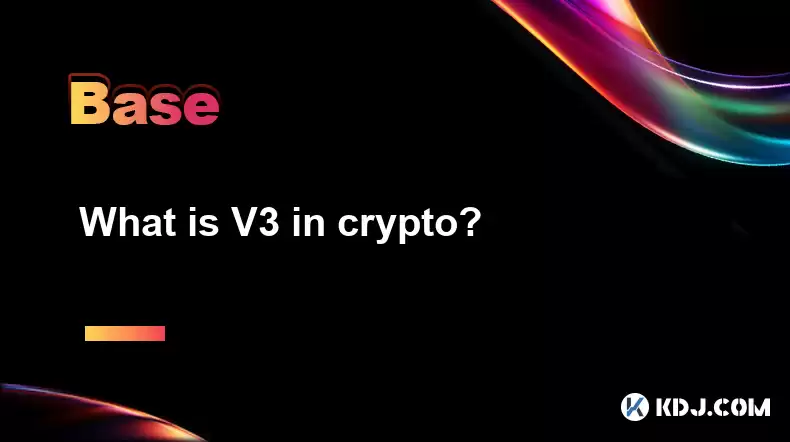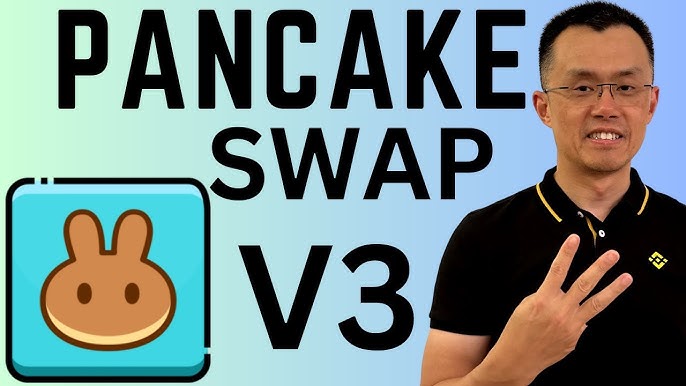-
 Bitcoin
Bitcoin $117500
2.15% -
 Ethereum
Ethereum $3911
6.19% -
 XRP
XRP $3.316
10.79% -
 Tether USDt
Tether USDt $1.000
0.01% -
 BNB
BNB $787.2
2.24% -
 Solana
Solana $175.2
4.15% -
 USDC
USDC $0.9999
0.00% -
 Dogecoin
Dogecoin $0.2225
8.40% -
 TRON
TRON $0.3383
0.28% -
 Cardano
Cardano $0.7868
6.02% -
 Stellar
Stellar $0.4382
9.34% -
 Hyperliquid
Hyperliquid $40.92
7.56% -
 Sui
Sui $3.764
7.63% -
 Chainlink
Chainlink $18.48
10.66% -
 Bitcoin Cash
Bitcoin Cash $582.1
1.88% -
 Hedera
Hedera $0.2601
6.30% -
 Avalanche
Avalanche $23.33
4.94% -
 Ethena USDe
Ethena USDe $1.001
0.02% -
 Litecoin
Litecoin $122.3
2.04% -
 UNUS SED LEO
UNUS SED LEO $8.969
-0.27% -
 Toncoin
Toncoin $3.339
0.86% -
 Shiba Inu
Shiba Inu $0.00001287
4.30% -
 Uniswap
Uniswap $10.43
7.38% -
 Polkadot
Polkadot $3.861
5.08% -
 Dai
Dai $1.000
0.02% -
 Bitget Token
Bitget Token $4.513
3.41% -
 Monero
Monero $267.7
-6.18% -
 Cronos
Cronos $0.1499
4.14% -
 Pepe
Pepe $0.00001110
5.15% -
 Aave
Aave $284.9
8.28%
What is V3 in crypto?
Uniswap V3, Curve V3, and Synthetix V3 represent significant iterations, each offering innovations like concentrated liquidity (Uniswap), optimized pools for diverse assets (Curve), and expanded synthetic asset types (Synthetix).
Mar 21, 2025 at 03:53 pm

Centralized liquidity : Under the traditional liquidity provision model, liquidity is evenly distributed throughout the price range. However, actual transactions are often concentrated in specific price ranges, such as USDC-DAI trading pairs. On April 15, 2022, the liquidity pool of the pair was approximately US$86 million, 43 million DAI and 43 million USDC. The transactions mostly fluctuate around 43,000 USDC = 43,000 DAI. Deviating from this level will trigger arbitrage, allowing the price to return to around 1 USDC = 1 DAI, and most transactions are within the narrow range of 1 DAI = 0.99 USDC to 1 DAI = 1.01 USDC. In Uniswap V3, liquidity providers can focus liquidity in price ranges that are considered active in trading. Assume that there are 100,000 DAI and 100,000 USDC, and within the 0.99-1.01 price range, there are 100 USDC-DAI transactions worth US$100 in one minute, calculated at a 0.3% transaction fee, incurring a $30 handling fee. If Ethan provides 50,000 DAI and 50,000 USDC liquidity in the entire price range by v2, Effie provides the same amount of liquidity in the range of 0.99 - 1.01 with v3. Two people share the $30 handling fee equally in v2 mode, each with $15. In v3 mode, the price range is analogized to 10 "baskets", Ethan places $10,000 in each basket, Effie places all liquidity in one basket, and Ethan provides $10,000 in the range of 0.99 - 1.01, Ethan provides $100,000, Effie provides $100,000, and Effie deserves a handling fee of $100 / 110 * 30 = $27.3. In theory, using the narrowest price range, Uniswap V3 is 4000 times more efficient than v2, which means that it can obtain the same benefits as v2 in the set range with 4000 times less liquidity.

Multiple fee levels : Liquidity providers can choose different transaction fee levels according to different trading pairs and market conditions. For trading pairs with large price fluctuations and active transactions, you can choose a high fee level to obtain more returns; for trading pairs with relatively stable fees, you can choose a low fee level to attract more transactions, achieving small profits and quick turnover, so as to better manage risks and returns.
Flexible trading strategy : Users can set trading strategies such as stop loss and limit orders based on market conditions. When it is expected that the price of a crypto asset may fall back to a certain level, you can set a limit order to sell at the target price; if you are worried that the price will fall, you can set a stop loss order to automatically sell when the price drops to a certain level, so as to formulate a personalized trading plan based on your own judgment of the market and risk tolerance in the complex cryptocurrency market.
Optimized liquidity pool design : Curve V3 optimizes liquidity pools to accommodate a wider variety of asset portfolios. It not only supports efficient transactions between common stablecoins, but also better handles the combination of different types of stablecoins and other related assets. For example, in some specific multi-asset liquidity pools, Curve V3 can use algorithm optimization to make the exchange between different assets smoother and reduce slippage. For liquidity pools composed of mainstream stablecoins such as DAI, USDC, and USDT, users can enjoy lower transaction costs and exchange rates closer to the real market price when trading.
Improve capital efficiency : Curve V3 improves capital efficiency by improving liquidity management mechanisms. It adopts a dynamic liquidity allocation algorithm to automatically adjust the distribution of liquidity between different trading pairs according to the market's real-time trading needs. When the trading volume of a stablecoin trading pair suddenly increases, the system can quickly allocate more liquidity to the trading pair to ensure smooth transactions, while avoiding excessive liquidity idleness and improving the overall capital utilization efficiency.
Expand synthetic asset types : The V3 version greatly expands the types of synthetic assets that can be issued. Based on the previous version, in addition to the common synthetic fiat currencies, cryptocurrencies and other assets, support for more types of assets such as commodities and stock indexes has also been added. Users can create and trade synthetic assets linked to commodity prices such as gold and crude oil through the Synthetix platform, as well as synthetic assets tracking the performance of stock indexes such as the S&P 500, enriching investment options and market diversity.
Enhanced oracle integration : Synthetix V3 enhances integration with oracle. The oracle provides accurate price data for synthetic assets. The V3 version improves the accuracy and timeliness of price data by optimizing the oracle's data acquisition and verification mechanism. This ensures that the price of synthetic assets can closely follow their corresponding real-world asset price fluctuations, reduce the risk of price deviation, and ensure that users can operate based on reliable price information when trading synthetic assets.
Disclaimer:info@kdj.com
The information provided is not trading advice. kdj.com does not assume any responsibility for any investments made based on the information provided in this article. Cryptocurrencies are highly volatile and it is highly recommended that you invest with caution after thorough research!
If you believe that the content used on this website infringes your copyright, please contact us immediately (info@kdj.com) and we will delete it promptly.
- Stablecoins, Hong Kong, and On-Chain Finance: Navigating the Regulatory Maze
- 2025-08-08 12:30:12
- Tron's Sell-Off Spurs Altcoin Shift: What's Next for TRX?
- 2025-08-08 08:30:12
- Euler, DeFi, and Coinbase: A New York Minute on the Latest Buzz
- 2025-08-08 12:30:12
- RUVI Presale: Is the Growth Potential Real?
- 2025-08-08 09:10:12
- Sleep Token's US Takeover: Thornhill Rides the 'Even In Arcadia' Wave
- 2025-08-08 08:30:12
- FTT Token's Wild Ride: Creditor Repayments vs. Market Drop - A New Yorker's Take
- 2025-08-08 07:10:12
Related knowledge

How are flash loans used?
Aug 08,2025 at 01:08pm
Understanding Flash Loans in Decentralized FinanceFlash loans are a unique innovation within the decentralized finance (DeFi) ecosystem, allowing user...

What are common crypto trading strategies?
Aug 08,2025 at 12:42pm
Understanding Trend Following in Crypto TradingTrend following is one of the most widely adopted crypto trading strategies due to its simplicity and a...

How to read a crypto chart?
Aug 08,2025 at 10:35am
Understanding the Basics of a Crypto ChartA crypto chart is a visual representation of the price movements of a cryptocurrency over time. These charts...

What is the difference between CeFi and DeFi?
Jul 22,2025 at 12:28am
Understanding CeFi and DeFiIn the world of cryptocurrency, CeFi (Centralized Finance) and DeFi (Decentralized Finance) represent two distinct financia...

How to qualify for potential crypto airdrops?
Jul 23,2025 at 06:49am
Understanding What Crypto Airdrops AreCrypto airdrops refer to the distribution of free tokens or coins to a large number of wallet addresses, often u...

What is a crypto "airdrop farmer"?
Jul 24,2025 at 10:22pm
Understanding the Role of a Crypto 'Airdrop Farmer'A crypto 'airdrop farmer' refers to an individual who actively participates in cryptocurrency airdr...

How are flash loans used?
Aug 08,2025 at 01:08pm
Understanding Flash Loans in Decentralized FinanceFlash loans are a unique innovation within the decentralized finance (DeFi) ecosystem, allowing user...

What are common crypto trading strategies?
Aug 08,2025 at 12:42pm
Understanding Trend Following in Crypto TradingTrend following is one of the most widely adopted crypto trading strategies due to its simplicity and a...

How to read a crypto chart?
Aug 08,2025 at 10:35am
Understanding the Basics of a Crypto ChartA crypto chart is a visual representation of the price movements of a cryptocurrency over time. These charts...

What is the difference between CeFi and DeFi?
Jul 22,2025 at 12:28am
Understanding CeFi and DeFiIn the world of cryptocurrency, CeFi (Centralized Finance) and DeFi (Decentralized Finance) represent two distinct financia...

How to qualify for potential crypto airdrops?
Jul 23,2025 at 06:49am
Understanding What Crypto Airdrops AreCrypto airdrops refer to the distribution of free tokens or coins to a large number of wallet addresses, often u...

What is a crypto "airdrop farmer"?
Jul 24,2025 at 10:22pm
Understanding the Role of a Crypto 'Airdrop Farmer'A crypto 'airdrop farmer' refers to an individual who actively participates in cryptocurrency airdr...
See all articles

























































































